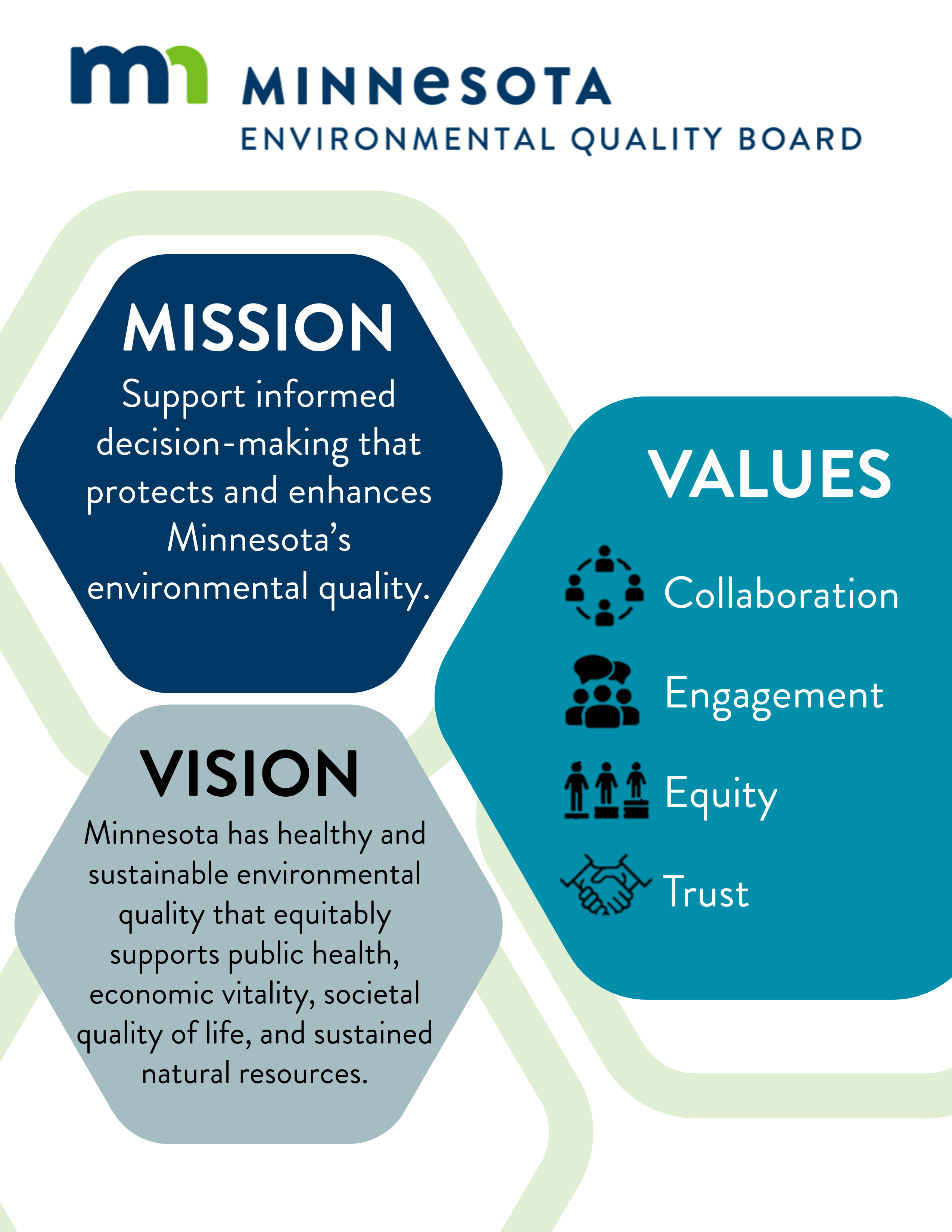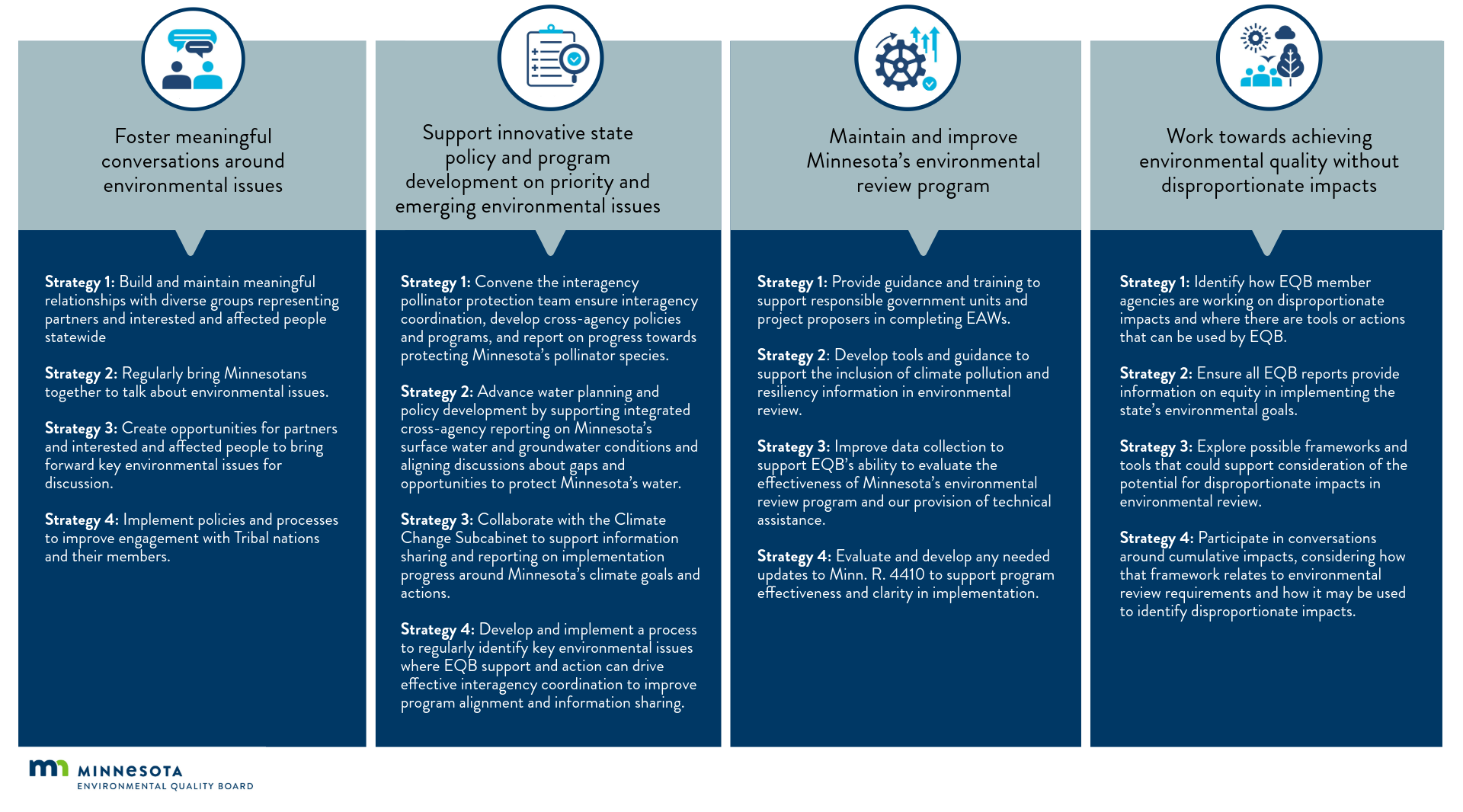
What is the EQB?
The Minnesota Environmental Quality Board (EQB) is a forum for leadership and coordination across Minnesota state agencies on complex, priority environmental issues. As a public-facing board, the EQB strives to engage Minnesotans and provide greater access to conversations regarding the future of our environment.
The Board has a responsibility to address issues affecting our water, land, air, energy, and climate. In addition the EQB functions as the coordinating body for Minnesota's Environmental Review Program. Environmental Review was established by the Minnesota Environmental Policy Act (MEPA); for a brief history of MEPA, see MEPA turns 50.
Mission
The EQB’s mission is to support informed decision-making that protects and enhances Minnesota’s environmental quality. We accomplish this by fostering meaningful conversations, supporting collaborative policy and program development, and ensuring effective environmental review of potentially impactful projects.
Vision
Minnesota has healthy and sustainable environmental quality that equitably supports public health, economic vitality, societal quality of life, and sustained natural resources.
Values
The EQB strives to incorporate the following key values in all our work and the way we do it:
- Collaboration: EQB facilitates connections across executive branch agencies, between branches of governments, and between government and those it serves.
- Engagement: EQB ensures that public voices, including diverse and underrepresented groups and those who will be most impacted, are actively included and considered in all our work.
- Trust: EQB is a trusted public entity in the work of enhancing Minnesota’s environmental quality and a reliable partner to State, Tribal, and local governments.
- Equity: EQB aspires to promote equity in the environmental, economic, and social wellbeing of all residents of Minnesota.
Strategic Plan: July 2024 - June 2029

Purpose and Overview
The purpose of this strategic plan is to provide a directional framework to guide EQB’s actions and decision-making over the next five years. The strategic plan aims to align our organizational aspirations with our capabilities to achieve meaningful and purposeful outcomes.
The strategic plan begins with EQB’s mission, vision, and organizational values. These three components provide high-level guidance about what work EQB can and should do and how that work should be done. It then lays out four key outcomes that the EQB wishes to achieve in support of our mission.
Each key outcome is followed by detailed strategies that represent the specific things EQB hopes to do over the next five years to support meeting the desired outcomes. These strategies will guide Board and staff activities, such as future work plans and decisions about allocation of resources.
Outcomes and Strategies
The outcomes are the results that the EQB aspires to achieve in our work. These outcomes represent long-term goals; they can be seen as ideals we are working to meet. We recognize that there are gaps between what we are accomplishing and the goals we have set. While multiple actions and approaches could be taken to support each outcome, focused work in specific areas will help ensure we are effectively decreasing those gaps and getting closer to the desired outcomes. Each outcome is followed by four strategies that define the actions and approaches the EQB will take in the coming five-year period to move towards achieving the specified outcomes.
1. The EQB fosters meaningful conversations around environmental issues
What does this mean? The EQB convenes open, approachable, and accessible conversations. EQB ensures that public voices – including diverse and underrepresented groups and those who are most likely to be impacted by an issue under discussion – are provided a range of opportunities to become involved in key environmental discussions and are actively included and considered. EQB builds and maintains meaningful relationships with diverse groups statewide to support equal access for underrepresented groups and environmental justice communities to participate in conversations, policy development, and program implementation. EQB listens and learns from the input provided.
- Strategy 1: Build and maintain meaningful relationships with diverse groups representing partners and interested and affected people statewide.
- Strategy 2: Regularly bring Minnesotans together to talk about environmental issues.
- Strategy 3: Create opportunities for partners and interested and affected people to bring forward key environmental issues for discussion.
- Strategy 4: Implement policies and processes to improve engagement with Tribal nations and their members.
2. The EQB supports innovative state policy and program development on priority
and emerging environmental issues
What does this mean? EQB facilitates interagency coordination so that state agency programs are aligned to support the state’s overall policy goals for public health and environmental protection. EQB provides a forum for sharing information about environmental problems – including the actions being taken and remaining gaps and opportunities – to make recommendations for collective state action to advance and improve environmental outcomes. EQB develops and shares data and information about key issues to serve as a foundation for policy and program development and to report on implementation progress. Current priority issues include climate, water, and biodiversity (pollinators).
- Strategy 1: Convene the interagency pollinator protection team ensure interagency coordination, develop cross-agency policies and programs, and report on progress towards protecting Minnesota’s pollinator species.
- Strategy 2: Advance water planning and policy development by supporting integrated cross-agency reporting on Minnesota’s surface water and groundwater conditions and aligning discussions about gaps and opportunities to protect Minnesota’s water.
- Strategy 3: Collaborate with the Climate Change Subcabinet to support information sharing and reporting on implementation progress around Minnesota’s climate goals and actions.
- Strategy 4: Develop and implement a process to regularly identify key environmental issues where EQB support and action can drive effective interagency coordination to improve program alignment and information sharing.
3. The EQB maintains and improves Minnesota’s environmental review program
What does this mean? The EQB is a valued source of information for anyone seeking assistance with environmental review. The EQB ensures that Minnesota’s environmental review program meets the objectives of the Minnesota Environmental Policy Act and provides information that supports understanding the impact proposed projects will have on the environment. The EQB monitors, measures, and strives to continuously improve program effectiveness, focused on how the program provides usable information, supports engagement with the public, and follows a sound process.
- Strategy 1: Provide guidance and training to support responsible government units and project proposers in completing EAWs.
- Strategy 2: Develop tools and guidance to support the inclusion of climate pollution and resiliency information in environmental review.
- Strategy 3: Improve data collection to support EQB’s ability to evaluate the effectiveness of Minnesota’s environmental review program and our provision of technical assistance.
- Strategy 4: Evaluate and develop any needed updates to Minn. R. 4410 to support program effectiveness and clarity in implementation.
4. The EQB works towards achieving environmental quality without disproportionate
impacts
What does this mean? Through conversations, the EQB works to understand and gather information about the unequal distribution of both environmental and public health benefits and environmental and public health burdens. EQB shares and presents this information about disproportionate impacts and potential opportunities to mitigate them. EQB works to support responsible governmental units and state agencies in considering disproportionate impacts in environmental review and policy development.
- Strategy 1: Identify how EQB member agencies are working on disproportionate impacts and where there are tools or actions that can be used by EQB.
- Strategy 2: Ensure all EQB reports provide information on equity in implementing the state’s environmental goals.
- Strategy 3: Explore possible frameworks and tools that could support consideration of the potential for disproportionate impacts in environmental review.
- Strategy 4: Participate in conversations around cumulative impacts, considering how that framework relates to environmental review requirements and how it may be used to identify disproportionate impacts.
Download our strategic plan below: